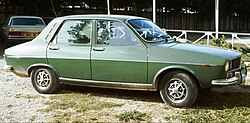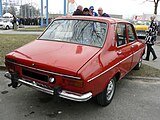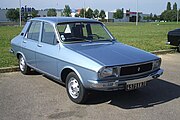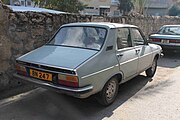Renault 12
| Renault | |
|---|---|
|
Renault 12 (1969-1975)
|
|
| 12 | |
| Production period: | 1969–1980 (under license until 2004) |
| Class : | Middle class |
| Body versions : | Limousine , station wagon |
| Engines: |
Petrol engines : 1.3-1.6 liters (37-83 kW) |
| Length: | Sedan: 4350 station wagon: 4410 mm |
| Width: | 1620 mm |
| Height: | 1440 mm |
| Wheelbase : | 2440 mm |
| Empty weight : | 900-930 kg |
| Previous model | Renault 8 and Renault 10 |
| successor | Renault 18 |
The Renault 12 - R12 for short - is a front-wheel drive car model of the (lower) middle class. From autumn 1969 to early 1980, more than 4.2 million vehicles of this type were produced in France, with licensed builds of the model still rolling off the assembly line until 2004.
Model history
General
In 1964, the development of a car began that should be robust and resistant enough to be used on the poor roads of North Africa . The first prototypes had three asymmetrically arranged headlights and the spare wheel on the trunk lid.
Later, this model should also close the gap between the front-wheel drive models Renault 6 and Renault 16 ; the rear-engine models R8 and R10 , which had been built since 1962 and 1965, were not to be built for long and the design trend was towards the front-engine .
In autumn 1969 the Renault 12 came on the market as a sedan. The basic version had disc brakes at the front and drum brakes at the rear, but no brake booster. In contrast to the R4 and R16 models, the R12 had a rigid rear axle that was guided by drawn trailing arms and a central wishbone.
In the summer of 1970, the range was expanded to include the station wagon, which was called “Variable” in Germany and “Break” in France. On the domestic market there were also versions for authorities and vans, some of which were delivered without rear doors, from the B-pillar without side glazing and / or without a rear seat, depending on the version. As is customary in Renault nomenclature, these models were named “Société”.
From the beginning of 1971, the "inconspicuous model boy", as the R12 was called by the magazine auto motor und sport at the time, was available as the sporty version " Gordini ". In France, the “Coupe R12G” replaced the previously popular “Coupe R8G” for newcomers to motorsport.
The R12 was also the technical basis for the two coupé versions derived from it, Renault 15 and Renault 17 . Both models were manufactured between July 1971 and August 1979.
Facelift
In August 1975 a revised version was introduced, with redesigned bumpers, headlights and taillights as well as a new dashboard (not in the R12 L). The licensed versions of the R12TS manufactured in Spain by FASA (Fabricación de Automóviles SA) up to the takeover by Renault France, as well as some models for other export markets, were equipped with double headlights.
In the spring of 1979, sales of the R12 to Germany were discontinued in favor of the successor model Renault 18 introduced in the previous year . Production in France ended in January 1980.
Engines and performance
| Type | Construction period | Code number | Displacement | power | Top speed |
|---|---|---|---|---|---|
| R12 / L / TL | 10.1969-07.1975 | R 1170 | 1289 cc | 40 kW (54 PS) | 142 km / h |
| R12 Gordini | 08.1970-12.1974 | R 1173 | 1565 cc | 83 kW (113 hp) | 185 km / h |
| R12 TS | 08.1972-07.1975 | R 1177 | 1289 cc | 44 kW (60 hp) | 150 km / h |
| R12 TR Automatic | 01.1974-07.1975 | R 1177 | 1289 cc | 44 kW (60 hp) | 145 km / h |
| R12 / L / TL | 08.1975–01.1980 | R 1170 | 1289 cc | 37 kW (50 PS) | 140 km / h |
| R12 TS | 08.1975–01.1980 | R 1177 | 1289 cc | 44 kW (60 hp) | 150 km / h |
| R12 Automatic | 08.1975–01.1980 | R 1177 | 1289 cc | 44 kW (60 hp) | 145 km / h |
The R12 in Australia
In Australia, the Renault 12 did not come onto the market until 1970 and was produced by Renault Australia . In 1978 the model name was changed to Renault Virage , and the bodywork was slightly redesigned as part of this. The production site was Melbourne ( Heidelberg district ). As in France, production ended at the beginning of 1980.
Licensed buildings
Dacia
The Renault 12 was more or less unchanged from 1969 to 2004 in Romania , at Dacia in Piteşti , as Dacia 1300 (from 1979: Dacia 1310/1410). After 35 years of production, the last examples, a sedan 1310 and a station wagon 1310, rolled off the production lines in Piteşti, which are now in the Romanian Automobile Museum, at the end of 2004. A total of 1,959,730 copies were made. The successor is the Dacia Nova .
A special feature of the Dacia 1300 was that, like the Ford Corcel, it was manufactured before the official premiere of the R12.
From 1975 to the end of 2006, Dacia also produced pick-up variants that the Renault R12 did not have (see Dacia Pick-Up ).
Toros
The Renault 12 was also manufactured under license in Turkey and produced there by Oyak-Renault between 1971 and 1989 as the Renault 12 and then until 2000 as the Renault 12 Toros.
Ford Corcel
Ford Brazil took over Willys-Overland in 1968 , which had previously worked with Renault and produced the Dauphine and Gordini models on site under license. Ford also took over the project for a modified version of the R12, which was being developed at the same time. Ford developed the car further and then sold it under the name Ford Corcel .
Trivia
In the documentary road movie Renault 12 , the filmmaker Mohamed El Khatik describes a journey from the French city of Orléans to Tangier in Morocco in an R12, which was considered a typical means of transport by Moroccans in the 1970s.
literature
- Jacques Borgé, Nicolas Viasnoff: Renault - The way to success (l'Empire de Billancourt, German edition), M. Kühsel Verlag, Darmstadt 1980, ISBN 2-85120-059-3 .
- Edouard Seidler: Renault - The way to a global company - 1945–1973. Edita SA, Lausanne / CH 1973, OCLC 245678646 .
- Edouard Seidler: The great Renault challenge (Le Défi Renault / original title, The Renault Challenge / English title, El Desafio Renault / Spanish title), Edita SA, Lausanne / CH 1981, ISBN 2-88001-118-3 . (Part of this book corresponds to the author's title The Path to Global Business. )
- Works publication: Renault - Premier Constructeur Français d'Automobiles. Paul Dupont-Verlag, Paris 1968, OCLC 7940488 .
- Ulrich Bethscheider-Kieser: Renault - In the sign of the rhombus. Motorbuch Verlag, Stuttgart 1995, ISBN 3-613-01658-3 .
Web links
Individual evidence
- ↑ Renault 12 by Mohamed El Khatik on Arte








